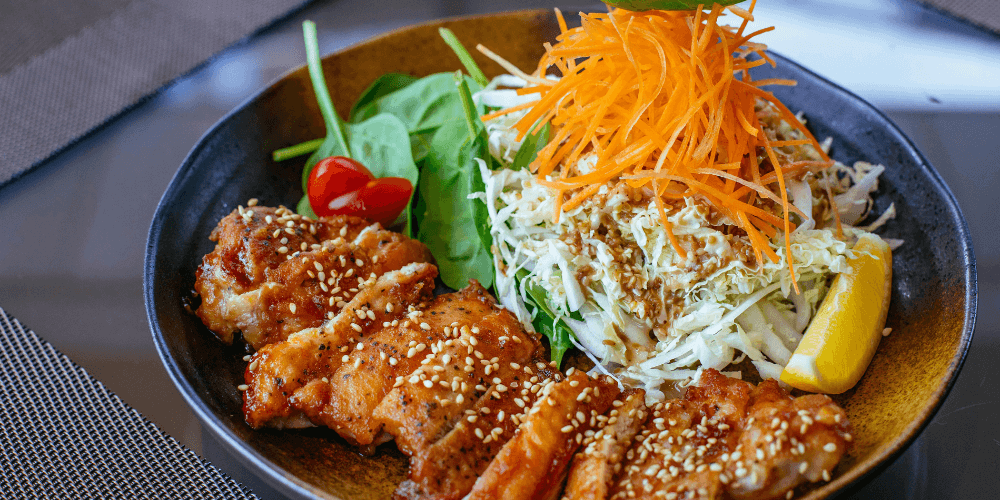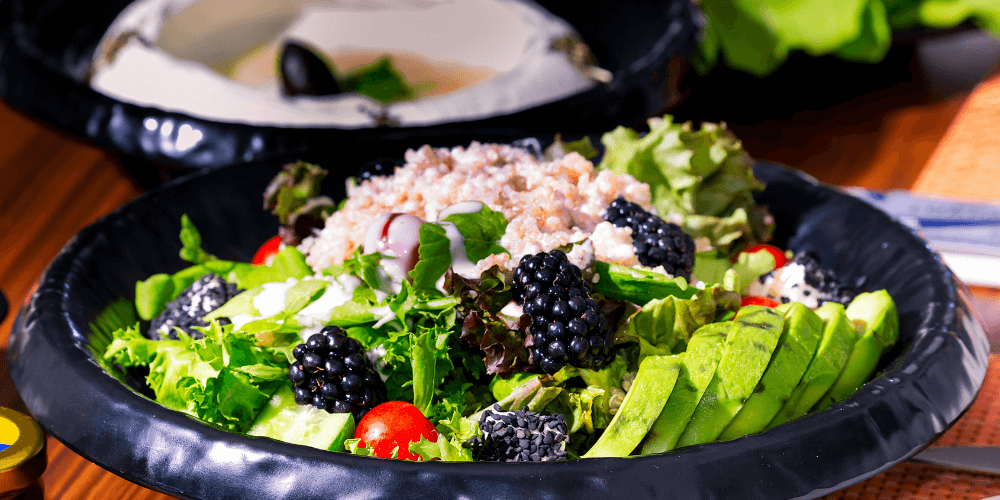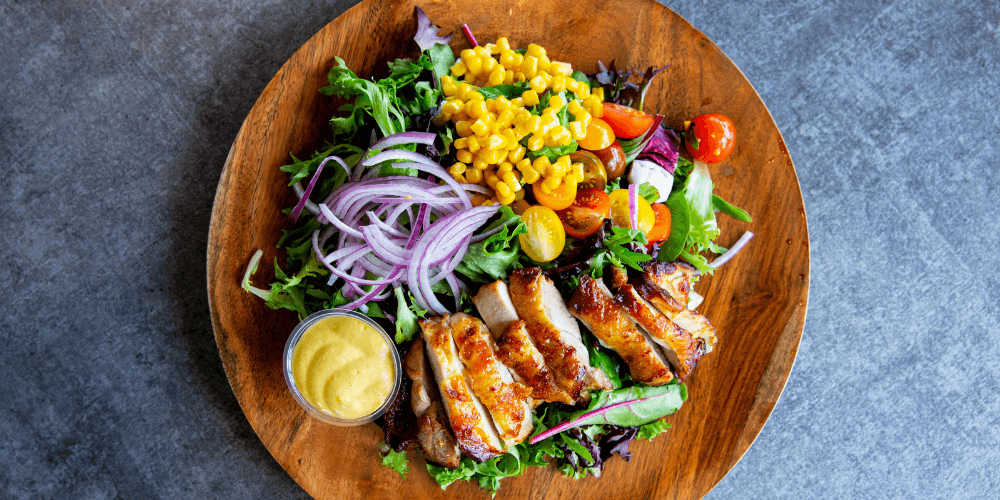Are you curious about the best plahttps://www.easyhealtheats.com/healthy-chicken-veggie-meal-prep-bowls/nt-based protein sources? The trend towards vegan and vegetarian diets is on the rise. This is because more people want to eat in a way that’s good for the planet and animals.
In 2025, you’ll find a wide variety of vegan protein meals. There are everything from filling bowls to new kinds of meat substitutes. These meals are not only good for you but also for the environment.

Key Takeaways
- Discover the top plant-based protein sources for a healthy diet
- Explore innovative vegan protein meal ideas for 2025
- Learn how to incorporate more protein-rich foods into your plant-based diet
- Find out how plant-based protein meals can support your overall well-being
- Stay updated on the latest trends in vegan and vegetarian cuisine
The Evolution of Plant-Based Eating in 2025
Plant-based eating has become very popular in 2025 due to health and environmental concerns. This has led to a big increase in demand for plant protein sources. Now, you can easily find vegetarian protein options in stores and restaurants.
Current Trends Shaping Protein Consumption
Several trends are changing how we eat protein in 2025. Veganism and flexitarian diets are becoming more common. These diets focus on plant-based protein over animal protein. People also want to eat in a way that’s better for the planet, leading to more demand for sustainable protein.
Why More Americans Are Choosing Plant Proteins
So, why are more Americans choosing plant proteins? There are many reasons. Health concerns, like lowering heart disease and cancer risks, are a big factor. People also care about the environment and want to reduce their carbon footprint. Animal welfare is another reason, as many choose vegetarian protein for ethical reasons.
Top Plant-Based Protein Sources for Your Meals
Exploring plant-based protein sources can change your meals and health goals. You’ll find foods with lots of protein and nutrients.
Legumes: The Protein Powerhouses
Legumes are top for plant-based protein. They include beans, lentils, and peas. These foods are full of protein, fiber, vitamins, and minerals.
A cup of cooked lentils has about 18 grams of protein. A cup of cooked black beans has around 15 grams.
Whole Grains with Impressive Protein Profiles
Whole grains are great for plant-based protein. Grains like quinoa, farro, and bulgur offer protein and complex carbs. Quinoa is a complete protein, with all nine essential amino acids.
A cup of cooked quinoa has about 8 grams of protein.
Nuts and Seeds: Small but Mighty
Nuts and seeds are small but full of protein and healthy fats. Almonds, chia seeds, and hemp seeds are especially good. An ounce of almonds has about 6 grams of protein.
A tablespoon of chia seeds has around 2 grams. Adding them to your meals boosts your protein.
| Food | Protein Content per Serving | Nutritional Benefits |
|---|---|---|
| Lentils (1 cup cooked) | 18g | High in fiber, iron, and potassium |
| Quinoa (1 cup cooked) | 8g | Complete protein, rich in magnesium and fiber |
| Almonds (1 oz) | 6g | Rich in healthy fats, vitamin E, and magnesium |
Breakthrough Plant-Based Protein Technologies of 2025
2025 is a big year for plant-based proteins, thanks to new tech. These advancements are making plant-based proteins taste better and be more eco-friendly. They also make these proteins easier for everyone to get.
Fermentation-Derived Proteins
Fermentation is changing the plant-based game. It uses tiny organisms like bacteria and yeast to create proteins. These proteins taste and feel like animal products. This method is good for the planet and gives people more options.
Precision Fermentation Innovations
Precision fermentation is making waves in the plant-based world. It uses advanced biotech to make proteins with perfect precision. This tech lets companies make meat alternatives that look and taste just like the real thing.
Cellular Agriculture Advancements
Cellular agriculture is also making big strides. It grows animal cells in a controlled space to make meat and other products. It’s still new, but it could greatly reduce the food industry’s environmental impact.
| Technology | Description | Impact |
|---|---|---|
| Fermentation-Derived Proteins | Using microorganisms to produce proteins | Reduces environmental impact, increases consumer choices |
| Precision Fermentation | Advanced biotechnology for specific protein production | Enables realistic meat alternatives |
| Cellular Agriculture | Growing animal cells in a controlled environment | Reduces environmental footprint of food production |
Breakfast Champions: High-Protein Morning Meals
Breakfast is key, and adding high-protein, plant-based foods makes it even better. You’ll find many tasty and healthy breakfast ideas. These include vegan and vegetarian protein sources.
Savory Breakfast Bowls with Tofu and Tempeh
Savory breakfast bowls are popular in plant-based diets. Mix tofu or tempeh with veggies, grains, and spices for a protein-rich bowl. Try a bowl with marinated tempeh, sweet potatoes, and avocado for a filling start.

Protein-Packed Smoothies and Overnight Oats
For busy mornings, protein-packed smoothies and overnight oats are perfect. Blend fruits with plant-based protein powders or soak oats in milk and chia seeds. Add nuts or seeds for more protein, making it a great vegetarian protein choice.
Recipe: Quinoa Breakfast Bowl with Tempeh Bacon
Try this simple recipe: Cook quinoa and mix it with tempeh bacon, spinach, and lemon juice. This quinoa bowl is packed with protein, fiber, and vitamins. Add avocado or nutritional yeast for extra flavor and nutrition.
Lunch Solutions: Quick Plant-Based Protein Meals
Finding quick and tasty plant-based protein meals for lunch is easier than you think. There are many plant protein sources to choose from. You can make meals that are both healthy and yummy.
Protein-Rich Grain Bowls and Salads
Grain bowls and salads are great for adding natural protein sources to your lunch. Start with quinoa or brown rice as the base. Then, add chickpeas, black beans, or tofu for protein. Finish with your favorite veggies and a simple vinaigrette for a meal that’s both filling and tasty.
- Quinoa and black bean bowl with avocado and salsa
- Kale salad with chickpeas, pumpkin seeds, and lemon-tahini dressing
Hearty Wraps and Sandwiches
Wraps and sandwiches are easy lunch options that can be made with plant-based proteins. Use whole grain wraps or bread. Fill them with tempeh, seitan, or hummus.
Recipe: Chickpea “Tuna” Salad Sandwich
This vegan tuna salad is made with chickpeas, vegan mayonnaise, Dijon mustard, and diced onions. Serve on whole grain bread with lettuce and tomato for a fulfilling lunch.
- Mash 1 cup of chickpeas with 2 tablespoons of vegan mayonnaise
- Add 1 teaspoon of Dijon mustard and 1 tablespoon of diced onion
- Season with salt and pepper to taste
- Serve on whole grain bread with lettuce and tomato
By adding these ideas to your lunch routine, you’ll enjoy a variety of quick, easy, and protein-rich plant-based meals.
Dinner Delights: Satisfying Plant-Based Protein Entrees
Exploring plant-based eating opens up a world of tasty dinner options. These meals are not only delicious but also good for your health.
Protein-rich plants make great meat alternatives. They’re flexible and can be used in many dishes, like stews and pasta sauces.
Bean and Lentil Main Dishes
Beans and lentils are key in plant-based meals. They’re packed with protein and fiber. You can make main dishes like lentil curries, bean chili, or lentil stews. These dishes are nutritious, filling, and tasty.
Try a lentil and vegetable stew for a protein-packed meal. Sauté your favorite veggies, add lentils and broth, and simmer until the lentils are soft.
Seitan and Tempeh Creations
Seitan and tempeh are great protein sources. Seitan, made from wheat gluten, tastes like meat and can be marinated and cooked in many ways. Tempeh, a fermented soybean product, has a nutty taste and is good in stir-fries or salads.
Recipe: Lentil Walnut Bolognese
Try this easy recipe for Lentil Walnut Bolognese: Cook lentils and mix them with sautéed onions, garlic, walnuts, and tomato sauce. Serve it over whole-grain pasta for a healthy, tasty meal. This dish shows how to use protein-rich plants to make a tasty meat alternative.
Adding these protein-rich ingredients to your dinners makes meals flavorful and healthy. Try different recipes and ingredients to find your favorite plant-based protein dishes.
The Best Plant-Based Protein Meal Delivery Services
For those who follow a plant-based diet, meal delivery services are a big help. They offer healthy, protein-rich meals easily. These services meet different needs, from those with little time to those who love cooking at home.
Subscription Services Worth Your Money
Many plant-based protein meal delivery services have subscription plans. These plans are convenient and flexible. They include a variety of vegan protein options to keep you full and healthy.
Services like Purple Carrot and Veestro let you choose meals based on your diet. They offer weekly plans that you can customize.
Ready-to-Eat Options for Busy Professionals
Busy people will love ready-to-eat plant-based protein meals. Companies like Freshly and Daily Harvest have meals that are high in vegan protein. They’re perfect for eating on the go.
These meals are not only easy to grab but also good for you. They’re a great choice for those with tight schedules.
Meal Kits for Home Cooking Enthusiasts
Cooking fans will enjoy meal kits from HelloFresh and Green Chef. These kits have everything you need for plant-based protein dishes. They come with pre-measured ingredients and simple instructions.
With these kits, you can make tasty, vegan protein-rich meals at home. It’s a fun way to try new recipes.
When picking a meal delivery service, think about your diet, lifestyle, and what you like. This will help you find the best service for you.
International Cuisine: Plant-Based Protein Across Cultures
Exploring global cuisines shows a rich variety of plant-based protein dishes. These dishes are both healthy and tasty. As you explore different cultures, you’ll find many creative ways to add vegetarian protein to your meals.
Asian-Inspired Protein Dishes
Asian cuisine is known for its wide use of plant proteins. You can enjoy dishes like tofu stir-fries, tempeh skewers, and seitan noodle soups. These are not only protein-rich but also full of flavor.

Mediterranean Plant Protein Classics
The Mediterranean region is full of plant-based protein options. You can try lentil stews, chickpea salads, and falafel wraps. These dishes are not just high in protein but also in fiber and other nutrients.
Latin American Bean-Based Recipes
Latin American cuisine is known for its bean-based dishes, which are great sources of plant protein sources. Try making black bean tacos, feijoada (a hearty bean stew), or grilled corn and bean salads.
Recipe: Tofu Tikka Masala
Tofu Tikka Masala is a popular dish inspired by India. It’s both flavorful and high in protein. To make it, marinate extra-firm tofu in yogurt, lemon juice, and spices, then grill and simmer it in a creamy tomato sauce. Serve it over basmati rice or with naan bread for a fulfilling meal.
This dish shows how vegetarian protein can be the main attraction in a delicious meal. By adding tofu to your diet, you can enjoy a protein-rich meal that’s also good for the environment.
Meal Prep Strategies for Plant-Based Protein Success
To succeed in your plant-based journey, effective meal prep is key. It helps you add natural protein sources to your diet. By planning and preparing meals, you can meet your protein goals easily.
Weekly Prep Guide
Begin by planning your meals for the week. Pick a day, like Sunday, for meal prep. Start with cooking big batches of protein-rich grains like quinoa and farro, and legumes like lentils and chickpeas. These can be used in many dishes all week.
For instance, make a big batch of lentil soup on Sunday. Use it for lunches all week. Just reheat and serve with whole grain bread or a green salad.
Storage Solutions for Plant Proteins
Proper storage keeps your plant proteins fresh and nutritious. Use airtight containers for cooked grains, beans, and roasted nuts. Labeling helps you keep track and use the oldest items first.
Batch Cooking Techniques
Batch cooking saves time by making large amounts of one ingredient or meal. For plant-based proteins, cook a lot of tofu or tempeh. Use it in different recipes all week. Marinate and bake or stir-fry in bulk, then portion into containers for easy meals.
As Forks Over Knives says, “Batch cooking is a lifesaver on busy weekdays.” It helps you quickly make a healthy meal. By using these strategies, you’ll stick to a plant-based diet rich in natural protein.
Nutritional Considerations for Plant-Based Protein Meals
When you start eating plant-based protein meals, it’s important to think about their nutritional value. These meals are very nutritious but there are a few things to remember. This will help you get the most health benefits from them.
Ensuring Complete Amino Acid Profiles
One key thing to remember about plant-based protein meals is making sure they have all the amino acids your body needs. Unlike animal proteins, many plant proteins are missing some amino acids. To fix this, mix different plant proteins together during the day.
For example, eating legumes with whole grains or nuts with seeds can give you all the amino acids you need.
Examples of complementary protein combinations include:
- Black beans with brown rice
- Lentil soup with whole-grain bread
- Tofu stir-fry with cashews and vegetables
Addressing Common Nutrient Concerns
When you eat plant-based, you also need to think about other nutrients like vitamin B12, iron, calcium, and omega-3 fatty acids. Many plant proteins don’t have these nutrients. For example, vitamin B12 is mostly found in animal products, so you might need fortified foods or supplements.
Here are some tips to address these nutrient concerns:
- Choose fortified plant milk for calcium and vitamin B12
- Include iron-rich foods like lentils and dark leafy greens in your diet
- Consume walnuts or chia seeds for omega-3 fatty acids
Supplementation: When Is It Necessary?
Even with a good plant-based diet, you might need supplements sometimes. For example, vegan diets often need vitamin B12 supplements. You might also want to think about omega-3 supplements from algae if you’re not getting enough from food.
Before starting any supplements, it’s advisable to:
- Consult with a healthcare professional or registered dietitian
- Get your nutrient levels checked to identify any deficiencies
- Choose high-quality supplements from reputable brands
By paying attention to these nutritional points, you can enjoy the benefits of plant-based protein meals. And you can keep your diet balanced and healthy.
Conclusion: Embracing the Future of Plant-Based Eating
Exploring plant-based protein meals is more than just a diet change. It’s a lifestyle choice that benefits your health, the planet, and animals. Adding vegan and vegetarian protein to your meals can greatly improve your well-being.
Thanks to new plant-based protein technologies, you can enjoy a variety of tasty and healthy options. Legumes, whole grains, nuts, and seeds are just a few examples. They help you make satisfying meals that are also high in protein.
As you keep exploring plant-based eating, you’re joining a big movement. This movement is changing the way we think about food. By choosing plant-based meals, you help support sustainable farming, lower your carbon footprint, and promote kindness in the food world. You can make a big difference, starting with every meal.
FAQ
What are the best sources of plant-based protein?
Legumes, whole grains, nuts, and seeds are great for plant-based protein. Lentils, chickpeas, quinoa, almonds, and chia seeds are all good. They’re easy to add to your meals.
How can I ensure I’m getting enough protein on a vegan diet?
Eat a variety of plant-based protein sources like legumes, whole grains, and nuts. Meal prep and plant-based protein meal delivery services can also help.
Are plant-based protein powders a good option for vegans?
Yes, they’re a convenient way to increase your protein. Choose pea, hemp, or brown rice protein powders. Make sure they’re free from animal products.
Can I get all the essential amino acids from plant-based sources?
Yes, by eating a variety of protein-rich foods. Legumes, whole grains, and nuts are good sources. Combining different foods ensures you get all essential amino acids.
How do I choose the best plant-based protein meal delivery service?
Look at menu variety, nutritional content, and price. Choose services with vegan and vegetarian options. Read reviews and check ingredients and preparation methods.
What are some high-protein breakfast ideas?
Try tofu scrambles, tempeh bacon, or quinoa bowls for breakfast. You can also blend protein powder into smoothies or make overnight oats with nuts and seeds.
Can I make plant-based protein meals in advance?
Yes, meal prep saves time and ensures enough protein. Prepare meals like lentil soups, chickpea salads, or quinoa bowls. Store them in the fridge or freezer.
How do I store plant-based protein sources?
Store them in a cool, dry place. Legumes, whole grains, and nuts go in airtight containers. Tofu and tempeh need the fridge or freezer to stay fresh.

